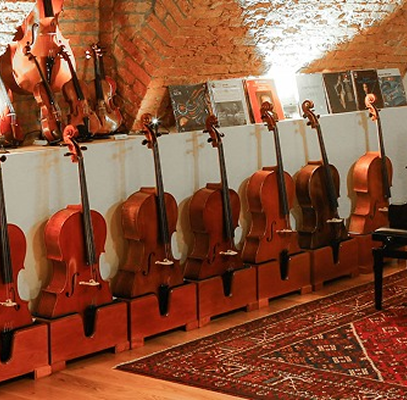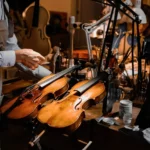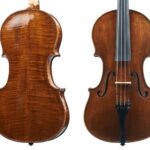Violin Bow Techniques
Back to BlogMastering the Bow: Essential Violin Bow Techniques for Expressive String Playing
If the violin sings through its strings, it is its bows through which it speaks. To the naive observer, bowing may seem simply a technical means to produce sound, but only a skilled violist knows that it is the origin of all expression. Bowing takes a note and makes a sentence out of it, a phrase, and a narrative. All subtleties, swellings, or whispers of tone start in the hand that cradles the bow.
Whether you’re a new artist or an accomplished performer, mastering and honing violin bow techniques is the key to freedom of emotion on stage. It’s not just mechanics; it’s about meaning — and the power to express it, gesture by gesture. On this journey into expressive playing, we explore the essential violin bow strokes that form the core of your sound, and how the right approach — physically and emotionally — can transform your playing from capable to unforgettable.
The Bow as an Extension of the Self
Before we get into violin bow techniques, let’s understand what the bow really is: an extension of your voice. Unlike the fingers of the left hand, which have pitch and placement to dictate, the bow has tone, dynamics, rhythm, and color to control. It is where feeling becomes form. Traditionally, the finest violinists — from Fritz Kreisler to Itzhak Perlman — have not merely been admired for their intonation but for the expressive nature of their bowing. Each developed a characteristic phrasing and sound that grew out of a unique vocabulary of movement, pressure, and timing.
Top-notch bowing is not a set system- It is living, breathing communication between the body, the bow, and the music itself.
The Foundation: Holding the Bow with Purpose
All journeys start with fundamentals, and for violinists, it starts with holding the bow. The proper bow hold is more than ergonomics — it’s developing fluidity and command. The majority of players start off with the Franco-Belgian or the Russian bow hold, both having their own philosophies. The Franco-Belgian is all about balance and quickness through an open hand position, whereas the Russian grip provides solidity and articulation through direct involvement of the fingertips.
Irrespective of style, the fundamentals do not change:
- The bow has to be held, not grasped.
- Fingers should be supple but firm, leading the bow and not fighting it.
- Wrist and arm should be able to move with natural freedom, not mechanical rigidity.
In the end, the bow hold should feel like a dialogue — a gentle but authoritative touch that engages the instrument to speak.
Core Violin Bow Techniques for Expressive Playing
A real artist only learns the rules in order to break them in the service of expression. The following are the building blocks of violin bow strokes that comprise the emotional vocabulary for string players:
1. Legato – Singing Through the Strings
Legato bowing creates smooth, seamless sound, imitating the human voice. Played with equal pressure and a stable arm, legato facilitates lyrical phrasing and the sense of continuous breath.
Emotional role: Warmth, tenderness, romanticism
Master tip: Practice long, slow bows across all strings, emphasizing bow speed and even tone from frog to tip.
2. Staccato – Short, Articulate, Alive
Staccato is composed of brief, separated strokes. It can be played with the bow lifting off the string (off-the-string staccato) or staying on it (on-the-string staccato).
Emotional role: Clarity, playfulness, tension
Master tip: Employ controlled finger and wrist movement, not arm power, to produce clean attacks.
3. Spiccato – Bouncing with Grace
Spiccato is a light, bouncing stroke produced by allowing the bow to naturally rebound off the string. It demands sensitivity to the balance of the bow and the elasticity of your wrist.
Emotional role: Joy, wit, agility
Master tip: Begin slowly and close to the balance point of the bow. Let gravity and rebound work for you.
4. Martelé – The Hammered Note
From the French word for “hammered,” martelé is a firm, accented bow stroke used to attack each note with precision and strength.
Emotional role: Drama, power, clarity
Master tip: Prepare the bow on the string with pressure, then release it quickly, creating a burst of energy.
5. Sautillé and Ricochet – Virtuosity in Motion
These are sophisticated bouncing devices. Sautillé is an energetic, spontaneous rebound stroke played in fast passages. Ricochet is a deliberate multiple bounce in a single bow direction, as in Paganini or Saint-Saëns.
Emotional role: Sparkle, brilliance, lightness
Master tip: Allow the bow to work; stiffness will wreck the bounce. Release your tension and confine the motion to your wrist.
The Secret Ingredient: Bow Distribution and Control
Mastery of the techniques is only one part of the job; the true art consists in knowing where and how to use the bow, i.e., whether at the frog, middle, or tip, as this allows you to produce music to your liking. For example, the tip is generally used for gentle, floating phrases while the frog helps produce accented notes and create bold entrances. The middle, in turn, is used for balancing notes and a neutral effect.
What sets apart advanced players is their ability to remarkably modulate bow speed and pressure in real-time. It’s like having an intimate knowledge of how to slow down to emphasize emotions, speed up to generate excitement, or add pressure to build a crescendo.
The Master’s Speak: A Lesson in Musicality
Bowing comes with its own nuances, and an effective way to master them is to take a cue from the masters themselves. In other words, listening to the way Heifetz executes a martelé or how Hilary Hahn achieves a singing legato will teach you invaluable lessons about violin playing more than sheet music can convey.
Yo-Yo Ma exemplifies an artist who, despite being a cellist, amazingly commands both phrasing and bow control. By controlling the bow’s movement with purpose, he manages to turn it from a whisper to a roar. Bowing can be seen as much like language, where tone is everything.
A violin is hand-built mainly for sound and pathos, but the main role of the bow is to ensure the correct tone is produced. One of the most distinctive characteristics of a high-quality bow, like one made by master makers in Cremona or Paris, is that it shows an exquisite balance of technique and expression. In the modern era, artisans such as those who work at Amorim Fine Violins have an eye for making this connection work.
Whether you’re singing a Bach partita or a love sonata, a well-made bow brings out the best of your technique and your voice. Choosing the correct bow is all about finding the correct fit, not just for your hands, but also one that agrees with your style and tone.
Enduring Dialogue: Pathway to Mastery
Achieving mastery of the bow is not so much an end in itself but more an ongoing relationship with the instrument. With each stroke you make, you will most likely be adding to your knowledge of the dynamics of producing music. Technique is just the instrument with which you dig deeper into the realm of rhythms and sound, and expression is art. Like any art, it gets better the more you play and bring passion to it while remaining faithful to the wisdom that existed before.
Beyond Technique: The Heart of the Bow
For a real artist, the violin bow is more than an instrument but an extension of his or her spirit and a means of conveying their innermost feelings. Violin Bowing techniques are not a matter of mechanics but the very lexicon for a universal language such as music, thus making the musician convey different emotions such as joy, sadness, and passion without pronouncing a single word.
So the next time you play, don’t just think about the “how,” think about the “why” behind every stroke. It’s only when intention and technique meet that your music truly lives. Ready to find a bow that propels your artistry forward? Browse the handcrafted collection at Amorim Fine Violins, a combination of centuries of heritage and contemporary craftsmanship. Our carefully selected collection seeks to arm you with the perfect bow, whether you’re refining your martelé or producing a silky smooth legato so that you produce music that resonates.









